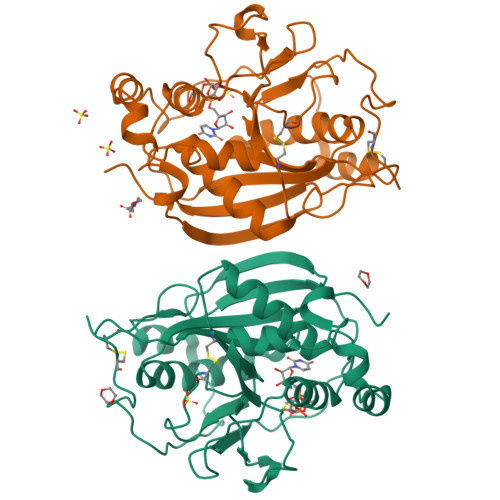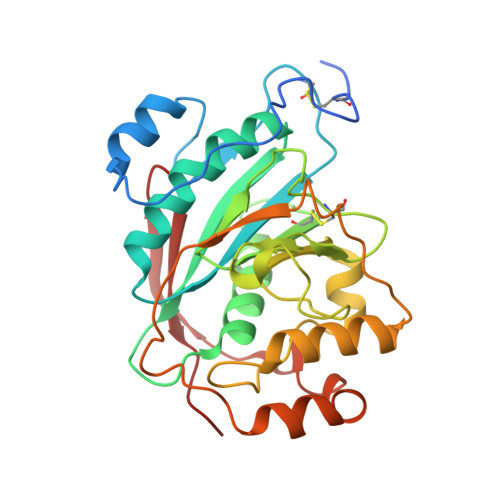Effect of the Met344His mutation on the conformational dynamics of bovine beta-1,4-galactosyltransferase: crystal structure of the Met344His mutant in complex with chitobiose
Ramakrishnan, B., Boeggeman, E., Qasba, P.K.(2004) Biochemistry 43: 12513-12522
- PubMed: 15449940
- DOI: https://doi.org/10.1021/bi049007+
- Primary Citation of Related Structures:
1TVY, 1TW1, 1TW5 - PubMed Abstract:
Beta-1,4-galactosyltransferase (beta4Gal-T1) in the presence of manganese ion transfers galactose from UDP-galactose (UDP-Gal) to N-acetylglucosamine (GlcNAc) that is either free or linked to an oligosaccharide. Crystallographic studies on bovine beta4Gal-T1 have shown that the primary metal binding site is located in the hinge region of a long flexible loop, which upon Mn(2+) and UDP-Gal binding changes from an open to a closed conformation. This conformational change creates an oligosaccharide binding site in the enzyme. Neither UDP nor UDP analogues efficiently induce these conformational changes in the wild-type enzyme, thereby restricting the structural analysis of the acceptor binding site. The binding of Mn(2+) involves an uncommon coordination to the Sdelta atom of Met344; when it is mutated to His, the mutant M344H, in the presence of Mn(2+) and UDP-hexanolamine, readily changes to a closed conformation, facilitating the structural analysis of the enzyme bound with an oligosaccharide acceptor. Although the mutant M344H loses 98% of its Mn(2+)-dependent activity, it exhibits 25% of its activity in the presence of Mg(2+). The crystal structures of M344H-Gal-T1 in complex with either UDP-Gal.Mn(2+) or UDP-Gal.Mg(2+), determined at 2.3 A resolution, show that the mutant enzyme in these complexes is in a closed conformation, and the coordination stereochemistry of Mg(2+) is quite similar to that of Mn(2+). Although either Mn(2+) or Mg(2+), together with UDP-Gal, binds and changes the conformation of the M344H mutant to the closed one, it is the Mg(2+) complex that engages efficiently in catalyses. Thus, this property enabled us to crystallize the M344H mutant for the first time with the acceptor substrate chitobiose in the presence of UDP-hexanolamine and Mn(2+). The crystal structure determined at 2.3 A resolution reveals that the GlcNAc residue at the nonreducing end of chitobiose makes extensive hydrophobic interactions with the highly conserved Tyr286 residue.
Organizational Affiliation:
Structural Glycobiology Section, Laboratory of Experimental and Computational Biology, SAIC-Frederick, Inc., Center for Cancer Research, National Cancer Institute, Frederick, Maryland 21702-1201, USA.






















